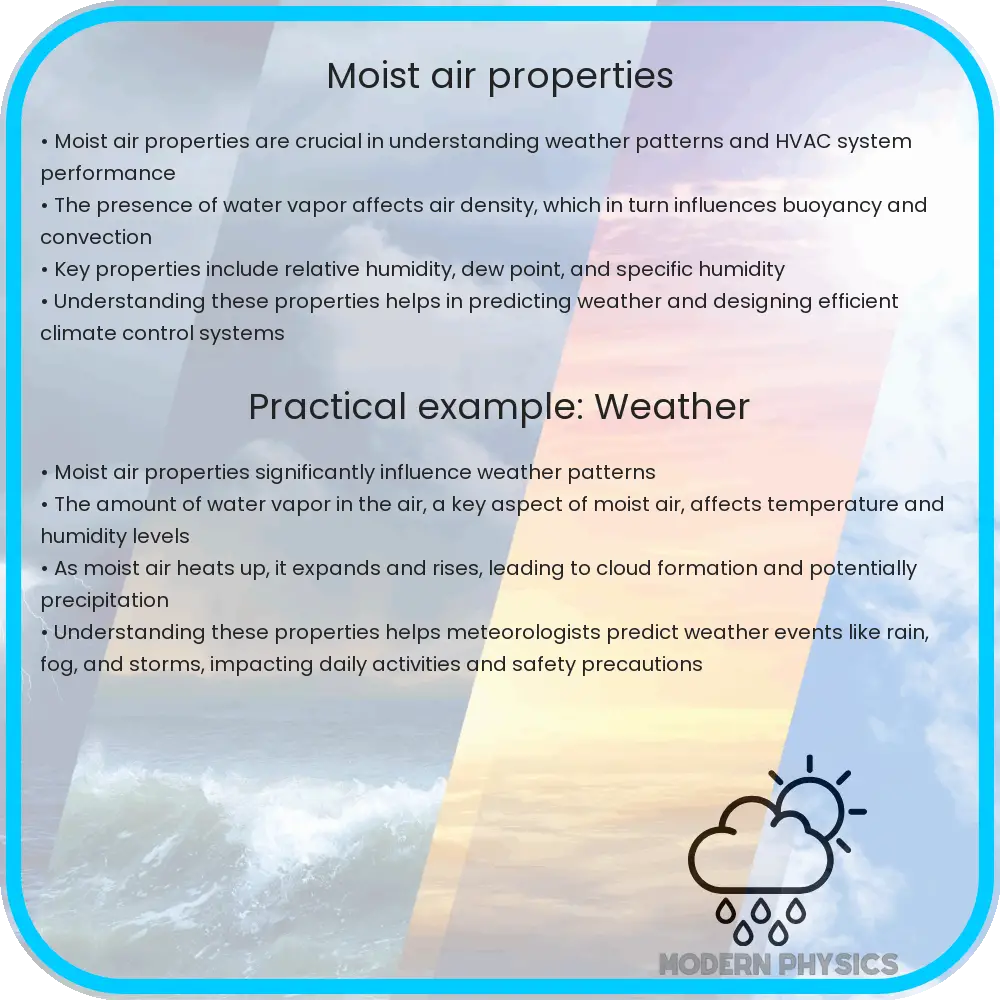Explore the crucial roles of humidity, enthalpy, and density in moist air, vital for HVAC design, weather forecasting, and industrial processes.

Understanding Moist Air Properties: Humidity, Enthalpy, and Density
Moist air, a mixture of dry air and water vapor, plays a crucial role in various engineering and meteorological applications. Understanding its properties like humidity, enthalpy, and density is essential for designing HVAC systems, predicting weather patterns, and more. This article delves into these fundamental properties of moist air.
Humidity: A Measure of Moisture Content
Humidity is a key parameter in understanding moist air. It’s a measure of the amount of water vapor present in the air. There are two main types:
- Absolute Humidity: Defined as the mass of water vapor per unit volume of air (g/m3), it provides a direct measure of moisture content.
- Relative Humidity: Expressed as a percentage, it compares the current amount of water vapor to the maximum amount the air can hold at a given temperature. This value changes with temperature and pressure.
Enthalpy: The Total Heat Content
Enthalpy, in the context of moist air, refers to the total heat content. It’s a crucial factor in thermodynamic processes, including heating, cooling, and air conditioning. Enthalpy of moist air is a combination of the sensible heat (related to temperature) and latent heat (related to phase change of water vapor). It’s usually measured in kJ/kg and can be calculated using the formula:
Enthalpy = (Specific Heat of Dry Air × Temperature) + (Humidity Ratio × (Specific Heat of Water Vapor × Temperature + Latent Heat of Vaporization))
Density: Mass per Unit Volume
The density of moist air, often measured in kg/m3, varies with temperature, pressure, and humidity. It’s lower than dry air at the same temperature and pressure due to the lighter molecular weight of water vapor compared to dry air. This property is crucial in calculations involving airflow, buoyancy, and thermal comfort.
In conclusion, understanding the properties of moist air such as humidity, enthalpy, and density is vital in many fields. These properties not only influence the design and operation of HVAC systems but also impact weather forecasting and environmental studies.
Practical Applications of Moist Air Properties
The knowledge of moist air properties extends beyond theoretical understanding and finds practical applications in various fields. Here’s how humidity, enthalpy, and density of moist air are applied in real-world scenarios:
- HVAC Systems: In heating, ventilation, and air conditioning (HVAC) systems, managing humidity and enthalpy is key to maintaining indoor air quality and comfort. Precise control of these properties ensures efficient energy usage and a healthy indoor environment.
- Weather Forecasting: Meteorologists rely on the understanding of moist air properties to predict weather patterns. Humidity and enthalpy play a significant role in the formation of clouds, precipitation, and storms.
- Industrial Processes: Many industrial processes, like drying or cooling, require strict control over the moisture content and temperature of air. Understanding the enthalpy and density of moist air helps in optimizing these processes for efficiency and safety.
Calculating Moist Air Properties
Calculating properties like humidity, enthalpy, and density often requires complex equations and the use of psychrometric charts. These charts graphically represent the properties of moist air at various temperatures and pressures, providing a valuable tool for engineers and scientists. Modern software and apps have also made it easier to perform these calculations accurately and quickly.
Environmental and Health Considerations
Moist air properties have significant environmental and health implications. For instance, high humidity levels can lead to mold growth and respiratory problems. Conversely, low humidity can cause dry skin and irritation. Environmental control systems must balance these factors to maintain healthy living and working conditions.
Conclusion
In summary, the study of moist air properties like humidity, enthalpy, and density is integral to numerous scientific and engineering disciplines. From designing efficient HVAC systems to predicting weather patterns and ensuring industrial safety, the understanding of these properties facilitates innovation and progress. As our world becomes increasingly reliant on technology and faces environmental challenges, the role of accurate and comprehensive knowledge of moist air properties becomes ever more critical.
